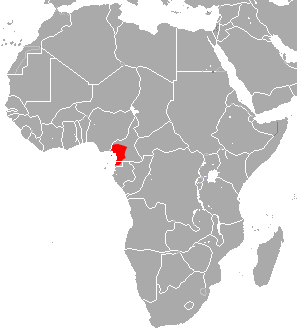Short-tailed roundleaf bat facts for kids
Quick facts for kids Short-tailed roundleaf bat |
|
|---|---|
| Conservation status | |
| Scientific classification | |
| Genus: |
Hipposideros
|
| Species: |
curtus
|
 |
|
| Short-tailed roundleaf bat range | |
The short-tailed roundleaf bat (Hipposideros curtus) is a small bat that lives in parts of Africa. It belongs to a family of bats called Hipposideridae. You can find this special bat in countries like Cameroon and Equatorial Guinea. It likes to live in warm, wet forests and dark caves. Sadly, its home is shrinking, which makes it an endangered animal.
Contents
About the Short-Tailed Roundleaf Bat
This bat was first officially described in 1921. An American scientist named Glover Morrill Allen gave it its name. The very first bat of this kind that scientists studied was found in 1920. It was collected by Reverend George W. Schwab in a place called Sackbayeme, Cameroon.
The bat's scientific name, "curtus", comes from a Latin word. It means "short." This name was chosen because this bat has a very short tail. It helps scientists tell it apart from other similar bats.
There are many different kinds of bats in the Hipposideros group. Scientists often put them into smaller groups. The short-tailed roundleaf bat is part of the "bicolor" species group.
What Does This Bat Look Like?
The short-tailed roundleaf bat is quite small. Its forearm, which is part of its wing, is about 42 to 47 millimeters long. That's about 1.6 to 1.8 inches.
These bats are also very light. One bat that was measured weighed around 7.1 grams. This is about 0.25 ounces, which is less than the weight of a few paper clips!
Where Does This Bat Live?
Scientists have confirmed that this bat lives in Cameroon and Equatorial Guinea. It might also live in Nigeria, but this needs more study. These bats can be found in places from sea level up to about 500 meters (1,640 feet) high. They prefer to live in tropical lowland forests.
In 2016, a group of these bats was found in southern Nigeria. This was near a special protected area called the Afi Mountain Wildlife Sanctuary. A scientist named Iroro Tanshi discovered them. She worked with local people to help protect these bats and their homes.
Why Is This Bat Endangered?
The IUCN (International Union for Conservation of Nature) lists the short-tailed roundleaf bat as endangered. This means it is at a high risk of disappearing forever.
There are a few reasons why this bat is in danger:
- Its special cave homes are very limited. They are probably found in an area smaller than 2,000 square kilometers (about 772 square miles).
- The places where it lives are becoming broken up. This is called habitat fragmentation. It means the forests are being cut down into smaller, separate pieces.
- The quality of its habitat is getting worse. This makes it harder for the bats to find food and safe places to live.


